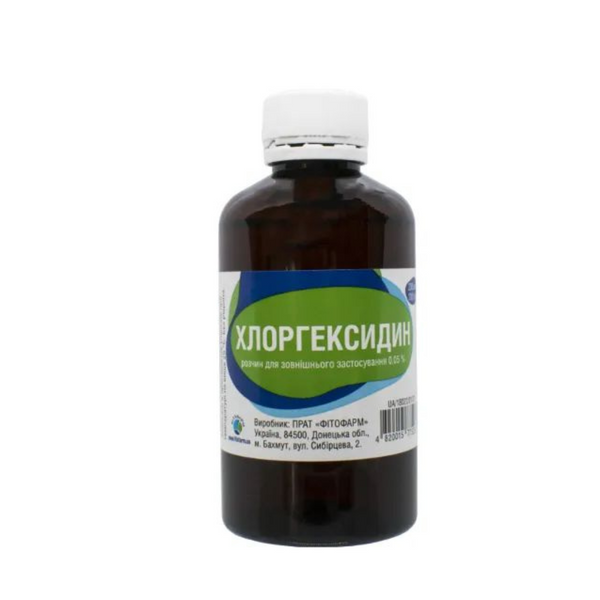|
Quantity
|
Out of stock
|
||
|
|
|||
Description
A transparent, colorless or slightly opalescent, odorless liquid.
Composition
100 ml of the preparation contains the active substance:
chlorhexidine bigluconate - 0.05 g.
Pharmacological properties
ATC-vet classification code: QD08AC02. Chlorhexidine is a local therapeutic and prophylactic antiseptic (antimicrobial), disinfectant, antiviral and antifungal agent of a wide spectrum of action; an agent for antisepsis and disinfection. It is one of the most active local antiseptic agents. Chemically, it is a dichlorine-containing derivative of biguanides.
Chlorhexidine blocks the amino groups of cellular proteins, penetrates the cell membranes of bacterial cells, settles in the cytoplasm and interferes with membrane function, preventing oxygen consumption, which leads to a decrease in the level of cellular ATP and cell death. Destroys DNA and disrupts DNA synthesis in microorganisms.
Chlorhexidine has a rapid and strong effect on most gram-negative microorganisms (Campylobacter spp., Escherichia coli, Salmonella spp., Shigella spp., Yersinia spp., Klebsiella spp., Haemophilus influenzae, Neisseria meningitidis, Francisella tularensis, Brucella spp., Rickettsia spp.) and gram-positive microorganisms (Erysipelothrix rhusiopathiae, Staphylococcus spp., Streptococcus spp., Mycobacterium tuberculosis). Chlorhexidine is also active against mycoplasmas and protozoa.
The fungicidal effect of chlorhexidine is manifested in a concentration of 0.05% at a temperature of 22 degrees and an exposure time of 10 minutes. It has fungistatic activity against fungi (Aspergillus niger, Aspergillus flavus, Candida albicans, Trichophyton gypseum, etc.).
Chlorhexidine has a virucidal effect against lipophilic viruses (including hepatitis A, B, C viruses, rotaviruses, enteroviruses, herpes viruses, pathogens of acute respiratory viral infections).
In the presence of blood and other organic substances, the antimicrobial activity of chlorhexidine bigluconate does not decrease.
Does not penetrate intact skin. Is practically not absorbed from the gastrointestinal tract. After accidental ingestion of 300 mg, the maximum concentration is reached after 30 minutes and is 0.206 μg/l. It is excreted mainly in the feces (90%), less than 1% is excreted by the kidneys.
Application
It is used as a therapeutic and prophylactic agent for various infections, for antiseptic treatment and disinfection. It is used for disinfection of the skin (abrasions, cracks); for bacterial and fungal diseases of the skin and mucous membranes; in surgery for the treatment of surgical wounds, purulent wounds, infected burns, pyoderma; for the treatment of inflammatory diseases of the oral cavity and pharynx (gingivitis, stomatitis, tonsillitis, pharyngitis, periodontitis, etc.), treatment of infectious and inflammatory diseases of the vagina and cervix (vaginitis, colpitis, cervical erosion, vulvar itching); for treatment and sanitation of the genital tract in urology, obstetrics and gynecology.
Dosage
Chlorhexidine as a preventive and therapeutic agent is used externally and locally. The solution is used in the form of irrigation, rinsing and applications - 5-10 ml of the solution is applied to the affected surface of the skin or mucous membranes with an exposure of 1-3 minutes 2-3 times a day (with a tampon or by irrigation). In case of microtrauma, the skin around the wound must be treated with the solution, after which a napkin soaked in the solution is applied to the wound and fixed with a bandage or plaster.
Contraindications
Hypersensitivity to the components of the drug. Tendency to allergic reactions and allergic diseases, dermatitis, viral skin diseases. It is not recommended for use in treating the conjunctiva and rinsing cavities, on wounds with a large surface, during operations in areas of the central nervous system and auditory canal, in ophthalmology, for introduction into the auditory canal.
Caution
To avoid the risk of developing dermatitis, the simultaneous use of chlorhexidine and iodine preparations is undesirable. Chlorhexidine bigluconate is a cationic substance incompatible with soap and other anionic substances (saponins, sodium lauryl sulfate, sodium carboxymethylcellulose). Compatible with preparations containing a cationic group (benzalkonium chloride, cetrimonium bromide). Ethanol enhances the effect of the drug. At a concentration of 0.05%, chlorhexidine bigluconate is incompatible with borates, carbonates, chlorides, citrates, phosphates, sulfates, forming poorly soluble precipitates.
Release form
Polymer bottles with a capacity of 100 and 200 ml with a dropper or spray.
Storage
Store in the manufacturer's packaging at a temperature of 1°C to 25°C in a dry, dark place inaccessible to children.
Shelf life - 3 years from the date of manufacture.
































